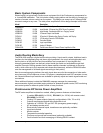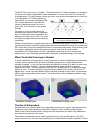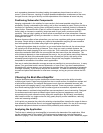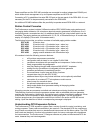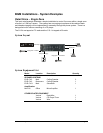
such as speaker placement, boundary loading (are speakers placed close to a wall or in a
corner?), size of the room, coupling of multiple speakers/subwoofers, reverberance of the room,
the type of music, the type of activity and the expectations of the listeners all come into play.
Positioning Subwoofer Components
Hanging a subwoofer in the middle of a room results in the lowest possible output from the
subwoofer. Placing a subwoofer at the ceiling, wall or floor increases its output. Placing it within a
few feet of a 2-boundary junction (like a ceiling/wall junction or a wall/wall junction) increases its
output further. Placement within 3 feet of a corner increases its output still more. In these cases,
there is both an increase in sensitivity (output per watt of input) and in maximum total SPL
capability. This can help in getting as much sound as possible from a few subwoofers. However,
there is a potential pitfall in placing a subwoofer in a corner: You can wind up with uneven bass
coverage in the room.
Because there are often so few subwoofers, you can have a problem getting even coverage of
the space. People sitting or standing very close to the subwoofer are going to hear excessive
lows while people who are father away might not be getting enough.
To resolve this problem keep in mind that as you move farther from the sub, the volume drops
off, typically at 6 dB per doubling of distance. Then, when you reach a certain distance, the
subwoofer level stops dropping off at such a high rate. This is called the critical distance, which is
where the reverberant field within the room equals the direct sound from the subwoofer. The
critical distance depends on how reverberant the room is. As you get farther past critical distance,
even though the level of the subwoofer doesn't drop off nearly as quickly, the quality of the
subwoofer sound might not be as good. But even though this may happen, it's sometimes
acceptable for subwoofers in business music applications.
One way to make the subwoofer coverage as even as possible is to use more than one. In many
places, it's a good idea to add a second subwoofer, or more. Even if you don't need additional
subwoofers for volume reasons, you might want to consider them just for evenness of subwoofer
coverage. Generally, if you have to use just one subwoofer, it is best to sacrifice the sensitivity
increase and place the subwoofer for most even coverage, as long as you can achieve the SPL
goals.
Choosing the Best Mixer/Amplifier
Practical distributed sound system installations almost always require the ability to handle
multiple signal inputs. Pages may originate from two or more sources, the telephone system and
a hand-held microphone, for example. Background music from two selectable sources, with
muting keyed to the paging input(s), may also be required. There may even be a need for a low-
level noise-masking signal mixed in with the other signals at a consistent, adjustable level.
For these reasons, combined mixer/amplifiers are commonplace in sound contracting. Designed
to handle several audio inputs at different signal levels and source impedances, such units
incorporate mixing and automatic muting along with amplification. By efficiently consolidating
often-used functions in a single enclosure, they greatly simplify routine installations, reducing
costs and increasing reliability.
In this article, we examine the criteria for selecting mixer/amplifiers, describe the range of alterna-
tives offered by ElectroVoice Sound, and suggest applications for each. Our aim is to encourage
appropriate equipment choices to maximize both profitability and customer satisfaction.
Analyzing the Application
The first step in selecting a mixer/amplifier is to examine the demands of the application. What
are the intended uses for the system? Will background or foreground music be required in
addition to paging? If so, from what type of source: FM/AM radio, tape, or both? Where will pages
ElectroVoice/Dynacord BGM Guide Page 21



